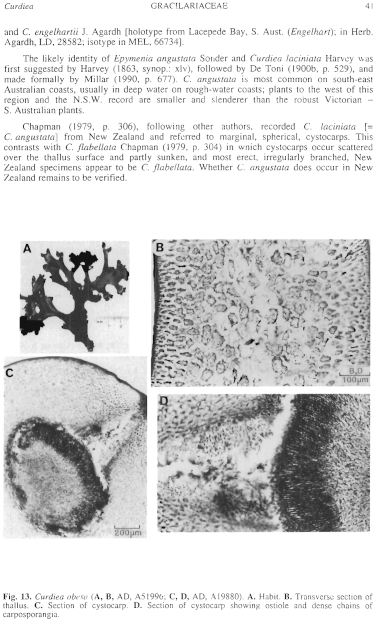|
|
|
|
|
|||||||||||
|
Electronic Flora of South Australia Species Fact Sheet
Phylum Rhodophyta – Class Florideophyceae – Order Gracilariales – Family Gracilariaceae
Selected citations: Huisman & Walker 1990: 417. Womersley 1950: 169.
Synonym
Sarcocladia obesa Harvey 1855a: 550; 1862: pl. 217. J. Agardh 1876: 427. De Toni 1900b: 426. De Toni & Forti 1923: 25, pl. III fig. 4. May 1965: 408.
Thallus (Fig. 13A) dark red-brown, decumbent but free of the substrate above the holdfast, 5–10 (–15) cm long, cartilaginous, more or less complanately and irregularly branched from the margins, branches (3–) 5–15 (–25) mm broad but irregular in width and often undulate, apices rounded, 0.5–1.0 mm thick just below apices, 1–1.5 mm thick below, with distinct upper and lower surfaces, the latter usually covered by sponge. Holdfast discoid, 2–10 mm across, with one to a few stipes; epilithic. Structure multiaxial, pseudoparenchymatous throughout (Fig. 13B), with a cortex 2–3 cells thick on the lower surface, becoming 4–6 cells thick on the upper surface, outer cells 3–7 (–11) µm in diameter and L/D 1–2, grading inwards to a medulla of large ovoid cells 50–100 µm in diameter, with walls 5–10 µm thick and numerous secondary pit-connections. Rhodoplasts discoid, numerous per cell.
Reproduction: Female plants with 2-celled carpogonial branches borne inside branch margins on mid cortical supporting cells. Carposporophytes (Fig. 13C) with a dense gonimoblast reticulum and a small basal fusion cell, producing a dense upper mass of erect gonimoblast filaments terminating in straight chains (Fig. 13D) of numerous subspherical to ovoid carposporangia 10–14 µm in diameter, maturing apically. Cystocarps on the branch surface but often near the margins, scattered, globose and usually sessile, (1–) 1.5–3 (–4) mm across; pericarp (Fig. 13C) massive, with inner tangentially elongate cells (continuing around base of the carposporophyte) and a medulla and cortex similar to the vegetative tissue, with an ostiole lined by branched filaments of short cells cut off from medullary pericarp cells. Spermatangia not observed.
Tetrasporangia not observed.
Type from Rottnest I., W. Aust. (Harvey); lectotype (Millar 1990, p. 341) in Herb. Harvey, TCD (Tray. Set 280).
Selected specimens: Port Denison, W. Aust., drift (Parsons, 8.xi.1968; AD, A33210). Safety Bay, W. Aust., drift (Womersley, 23.viii.1947; AD, A5844). Hamelin Bay, W. Aust., 1–2 m deep (Clarke & Engler, 1.ix,1979; AD, A50616). Point Valliant, Two People Bay, W. Aust., in large pool (Womersley, 30.viii.1979; AD, A50956). Elliston, S. Aust., 17 m deep outside bar (Shepherd, 12.v.1971; AD, A38676). Thistle I., S. Aust., 16 m deep (Baldock, 2.i.1964; AD, A27176). Pondalowie Bay, S. Aust., 4 m deep (Clarke, 14.ii.1981; AD, A51996) and drift (Womersley, 24.iv.1955; AD, A19880). Victor Harbor, S. Aust., drift (Womersley, 23.v.1953; AD, A18744). Sou'West R., Kangaroo I., S. Aust., 6 m deep (Mitchell, 24.viii.1963; AD, A26825). Baudin Rocks, Guichen Bay, S. Aust., 2–3 m deep (Shepherd, 15.ii.1975; AD, A46115). Nora Creina, S. Aust., 5–6 m deep (R. Lewis & Kraft, 13.v.1972; AD, A42219).
Distribution: Geraldton, W. Aust. (De Toni & Forti 1923, p. 25), to Nora Creina, S. Aust., on rough-water coasts from shaded shallow depths to deep water.
Taxonomic notes: C. obesa is characterised by its decumbent habit, resulting in a slightly thicker cortex on the upper surface and commonly a covering of sponge on the lower (shaded) surface. It is essentially of western distribution, reaching east to Nora Creina in South Australia.
References:
AGARDH, J.G. (1876). Species Genera et Ordines Algarum. Vol. 3, Part 1 — Epicrisis systematis Floridearum, pp. i-vii, 1–724. (Weigel: Leipzig.)
DE TONI, G.B. & FORTI, A. (1923). Alghe di Australia, Tasmania e Nouva Zelanda. Mem. R. Inst. Veneto Sci., Lett. Arti 29, 1–183, Plates 1–10.
DE TONI, G.B. (1900b). Sylloge Algarum omnium hucusque Cognitarum. Vol. 4. Florideae. Sect. 2, pp. 387–776. (Padua.)
HARVEY, W.H. (1855a). Some account of the marine botany of the colony of Western Australia. Trans. R. Ir. Acad. 22, 525–566.
HARVEY, W.H. (1862). Phycologia Australica. Vol. 4, Plates 181–240. (Reeve: London.)
HUISMAN, J.M. & WALKER, D.I. (1990). A catalogue of the marine plants of Rottnest Island, Western Australia, with notes on their distribution and biogeography. Kingia 1, 349–459.
KYLIN, H. (1932). Die Florideenordnung Gigartinales. Lunds Univ. Årsskr. N.F. Avd. 2, 28 (8), 1–88, Plates 1–28.
MAY, V. (1965). A census and key to the species of Rhodophyceae (red algae) recorded from Australia. Contr. N.S.W. natn. Herb. 3, 349–429.
MILLAR, A.J.K. (1990). Marine Red Algae of the Coffs Harbour Region, northern New South Wales. Aust. Syst. Bot. 3, 293–593.
WOMERSLEY, H.B.S. (1950). The marine algae of Kangaroo Island. III. List of Species 1. Trans. R. Soc. S. Aust. 73, 137–197.
The Marine Benthic Flora of Southern Australia Part IIIB complete list of references.
Publication:
Womersley, H.B.S. (28 June, 1996)
The Marine Benthic Flora of Southern Australia
Rhodophyta. Part IIIB. Gracilarialse, Rhodymeniales, Corallinales and Bonnemaisoniales
Reproduced with permission from The Marine Benthic Flora of Southern Australia Part IIIB 1996, by H.B.S. Womersley. Australian Biological Resources Study, Canberra. Copyright Commonwealth of Australia.
Illustration in Womersley Part IIIA, 1996: FIG. 13.

Figure 13 enlarge
Fig. 13. Curdiea obesa (A, B, AD, A51996; C, D, AD, A19880). A. Habit. B. Transverse section of thallus. C. Section of cystocarp. D. Section of cystocarp showing ostiole and dense chains of carposporangia.

|
Email Contact: State Herbarium of South Australia |

|